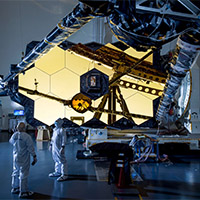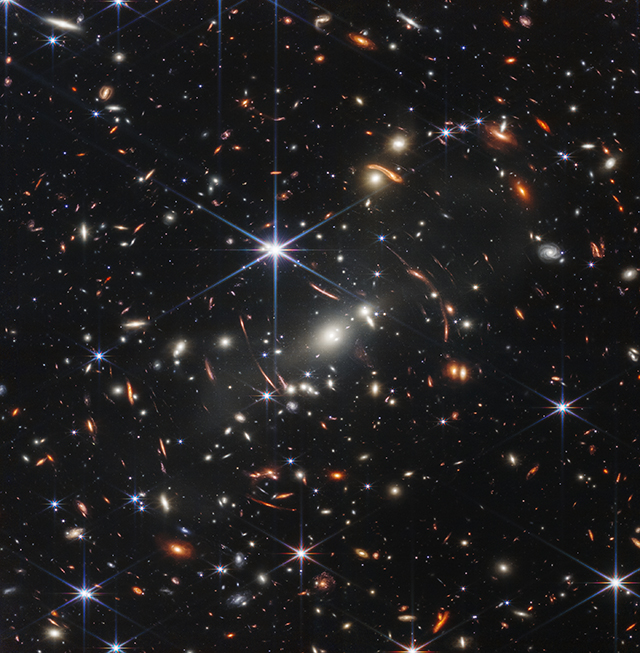NASA announces that President Biden will unveil the first James Webb Space Telescope image later today (Update: Image is now available)
posted Monday, July 11, 2022 at 2:00 PM EDT

Update: The first image from the James Webb Space Telescope is now available. It's the deepest and furthest image of the early universe, although it's not the earliest image NASA has ever captured.
The image is of SMACS 0723, a galaxy cluster known as Webb's First Deep Field. To get a sense of the patch of sky the image covers, imagine holding up a grain of sand at arm's length -- that's it. Such a tiny sliver contains thousands of galaxies. The new image was captured with Webb's Near-Infrared Camera (NIRCam) and it's a composite of images captured at different wavelengths. The composite is about 12.5 hours of images, which took weeks to capture.
The photo shows SMACS 0723 as it appeared about 4.6 billion years ago. The combined mass of the galaxy cluster acts as a gravitational lens and magnifies the distant galaxies behind it.

Original story:
In early June, NASA announced that the first full-color scientific images from the $10B James Webb Space Telescope would be released on July 12. There's been a last-minute change of plans. But don't worry, it's a good surprise.
Today, July 11, President Biden and NASA will unveil the first full-color photo from Webb ahead of the full reveal tomorrow morning. At 5 p.m. EDT on NASA TV, President Biden will release a single image from the White House and NASA Administrator Bill Nelson will provide remarks.
We can't contain the excitement for @NASAWebb's first full-color images!
— NASA (@NASA) July 11, 2022
On Monday, July 11 at 5pm ET (21:00 UTC), President Biden will unveil one of the space telescope's first images of deep space as a preview of what's ahead: https://t.co/kP5JdQEpVz pic.twitter.com/1wFZGkqrx8
We don't know what image will be unveiled, but we do know the possible subjects. Last week, NASA shared the list of Webb's first cosmic targets. The five targets are the Carina Nebula, WASP-96b (spectrum), Southern Ring Nebula, Stephan's Quintet and SMACS 0723. Let's take each in turn, as NASA describes them:
- Carina Nebula. The Carina Nebula is one of the largest and brightest nebulae in the sky, located approximately 7,600 light-years away in the southern constellation Carina. Nebulae are stellar nurseries where stars form. The Carina Nebula is home to many massive stars, several times larger than the Sun.
- WASP-96 b (spectrum). WASP-96 b is a giant planet outside our solar system, composed mainly of gas. The planet, located nearly 1,150 light-years from Earth, orbits its star every 3.4 days. It has about half the mass of Jupiter, and its discovery was announced in 2014.
- Southern Ring Nebula. The Southern Ring, or “Eight-Burst” nebula, is a planetary nebula – an expanding cloud of gas, surrounding a dying star. It is nearly half a light-year in diameter and is located approximately 2,000 light-years away from Earth.
- Stephan’s Quintet: About 290 million light-years away, Stephan’s Quintet is located in the constellation Pegasus. It is notable for being the first compact galaxy group ever discovered in 1787. Four of the five galaxies within the quintet are locked in a cosmic dance of repeated close encounters.
- SMACS 0723: Massive foreground galaxy clusters magnify and distort the light of objects behind them, permitting a deep field view into both the extremely distant and intrinsically faint galaxy populations.
The spectrum image of WASP-96b is fascinating because it'll be Webb's first exoplanet spectrum. Compared to Hubble, Webb sees longer wavelengths in the infrared, so Webb can peer into the atmosphere of exoplanets and learn about their compositions. Perhaps Webb will even find evidence that some exoplanets can support life, at least life as we know it. There are more than 4,000 known exoplanets and who knows what secrets they hold.
One of Webb's other images released tomorrow will be the deepest image of our universe that has ever been captured. We already had hints of Webb's capabilities thanks to a test image NASA released last week, but Webb's scientific images will go even further and look so much better. The Webb team hopes to learn more about how the universe formed.
"In comparison to Hubble, Webb does go deeper and certainly sharper in the infrared, especially the longer wavelengths like mid-infrared, bringing the universe into high definition,” said Jonathan Gardner, Webb deputy senior project scientist, at NASA’s Goddard Spaceflight Center.
Klaus Pontoppidan, JWST project scientist at the Space Telescope Science Institute (STScI) in Baltimore, said "I'm really looking forward to revealing the first color images to the world. But I also want to emphasize this is really only the beginning; we're only scratching the surface, we have in the first images, just a few days’ worth of observations. We’ll have many more years of observations, and we can only imagine what that will be. The next exciting phase is really to get the data out to the thousands of scientists around the world so they can dig into it. And then we can start a shared journey of discovery."
After tonight's surprise reveal, the full group of new images will be revealed tomorrow at 10:30 a.m. EDT on NASA TV and YouTube. Remarks begin tomorrow at 9:45 a.m.
(Via Engadget)